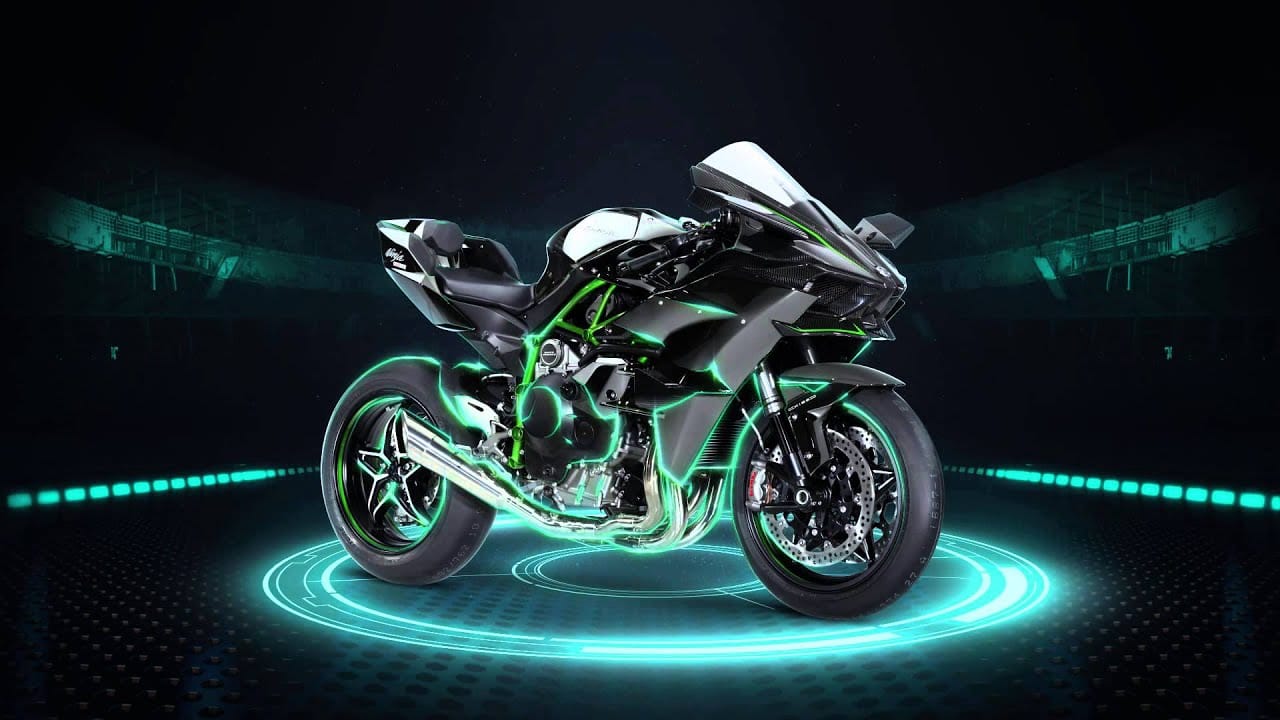The Kawasaki Ninja H2R is not just a motorcycle—it’s an engineering statement, a marvel of mechanical precision, and a pure adrenaline machine. Designed exclusively for the track, the H2R represents the pinnacle of Kawasaki’s racing technology. With its breathtaking power, aerodynamic design, and advanced features, it has become one of the most iconic and extreme motorcycles ever built.
1. Introduction to the Kawasaki Ninja H2R
First unveiled in 2014 at the EICMA Motorcycle Show, the Ninja H2R instantly captured global attention. It wasn’t just another superbike—it was a groundbreaking creation designed to break speed records and push the limits of performance. Unlike the road-legal Ninja H2, the H2R is a track-only machine with no compromise on power or noise restrictions.
The H2R is built for speed lovers, professional racers, and collectors who want the very best in motorcycle engineering.
2. Design & Aerodynamics
The first thing that strikes anyone about the Ninja H2R is its futuristic and aggressive styling. Every curve and edge has been crafted with aerodynamics in mind.
- Carbon-Fiber Winglets – These are not just for looks. They generate downforce, ensuring stability at extreme speeds.
- Mirror-Coated Matte Spark Black Finish – A unique paint job that reflects light differently depending on the viewing angle.
- Compact Frame – Trellis frame design for strength, rigidity, and precise handling.
Kawasaki collaborated with its aerospace division to perfect the aerodynamic elements, ensuring the bike cuts through the air like a missile.
3. Engine & Performance
The heart of the H2R is a 998cc supercharged inline-4 engine, capable of producing an astonishing 310 horsepower—and up to 326 HP with ram air intake. This makes it the most powerful production motorcycle ever built.
- Supercharger – Unlike turbochargers, the H2R’s centrifugal supercharger is designed in-house by Kawasaki, delivering instant power without lag.
- Top Speed – Capable of reaching over 400 km/h under the right conditions.
- Acceleration – 0 to 100 km/h in less than 3 seconds.
The engine’s scream at full throttle is unlike anything else—a high-pitched mechanical roar that announces its arrival long before it’s visible.
4. Track-Only Status
One of the reasons the H2R is so legendary is that it’s not street-legal. It lacks headlights, mirrors, and a traditional exhaust system compliant with road regulations. Instead, it’s tuned purely for track performance, meaning there are no compromises in terms of noise limits, emissions, or comfort.
Owning an H2R means you’re joining an exclusive club of enthusiasts who take their bikes to private tracks or closed-road events.
5. Suspension & Braking
The Kawasaki Ninja H2R’s suspension and braking systems are designed to handle the extreme speeds it can achieve.
- Front Suspension – KYB AOS-II inverted fork with adjustable preload, compression, and rebound damping.
- Rear Suspension – Uni-Trak with Öhlins TTX36 gas-charged shock for superior stability.
- Brakes – Dual semi-floating 330mm Brembo discs at the front and a single 250mm disc at the rear, providing incredible stopping power.
These components ensure that despite its raw speed, the bike remains planted, responsive, and safe under skilled hands.
6. Electronics & Rider Aids
High power requires high-level control, and the H2R is equipped with advanced electronics to help riders manage its monstrous output.
- Kawasaki Traction Control (KTRC) – Multiple modes for different track conditions.
- Kawasaki Launch Control Mode (KLCM) – For optimal acceleration without wheel spin.
- Kawasaki Intelligent Anti-lock Brake System (KIBS) – Precision braking at any speed.
- Quick Shifter – Seamless upshifts without using the clutch.
These systems don’t tame the bike—they simply allow experienced riders to extract maximum performance without losing control.
7. Sound & Sensation
Riding a Kawasaki Ninja H2R is an assault on the senses. The supercharger whine, the deep exhaust growl, and the rush of wind create an experience unlike any other motorcycle. Even spectators describe the H2R’s sound as something straight out of science fiction.
At high speeds, the bike feels as if it’s slicing through space—precise, powerful, and relentless.
8. Maintenance & Ownership
Owning an H2R is not for the faint-hearted, financially or mechanically. The bike requires regular, expert-level maintenance, and parts are expensive. Because it’s track-only, owners usually transport it in a dedicated trailer and store it in climate-controlled garages.
Insurance costs are also high, and availability is extremely limited, with Kawasaki producing only a few units each year.
9. Price & Availability
In India, the Kawasaki Ninja H2R is priced around ₹79.9 lakh (ex-showroom), making it one of the most expensive motorcycles available. Globally, it’s priced at around $56,000 USD.
However, it’s not just the price—it’s the exclusivity that makes it special. Very few riders will ever get the chance to ride, let alone own, an H2R.
10. Why the Ninja H2R is Legendary
The Ninja H2R is legendary because it represents unfiltered performance. While other bikes balance comfort, efficiency, and regulations, the H2R is a purebred speed demon. It’s the motorcycle equivalent of a Formula 1 car—an engineering masterpiece meant to push the limits of what’s possible.
Conclusion
The Kawasaki Ninja H2R is more than just a superbike—it’s a statement of engineering excellence. It’s for the select few who dare to experience the outer limits of speed, acceleration, and performance.
For most people, the H2R will remain a dream machine—admired from afar, heard screaming down a straightaway, and remembered as one of the most extreme motorcycles ever created.










